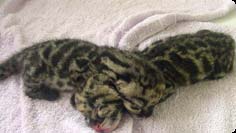 Spotlight on Zoo Science
Spotlight on Zoo Science
May 26, 2004
Clouded Leopard Baby Boom
Three clouded leopards were born on April 26 at the Khao Kheow Open Zoo in Chonburi, Thailand, thanks to the efforts of the Thailand Clouded Leopard Consortiuman international collaboration between Asian and U.S. scientists, including several scientists at the National Zoo.
 |
| Day-old clouded leopard cubs born on April 26 in a Thailand zoo. |
National Zoo reproductive scientist JoGayle Howard and Nashville Zoo President Richard Schwartz coordinate the consortium, made up of scientists from the Zoological Park Organi-zation of Thailand, Smithsonian’s National Zoo, Nashville Zoo, Asian Wildlife Consultancy, and the Clouded Leopard Species Survival Plan.
The consortium is dedicated to developing an improved nutrition, husbandry, and breeding program for clouded leopards in zoos in Thailand, and hopes to restore the population of this species, which the IUCN Red List considers vulnerable to extinction. Fewer than 10,000 of these forest-living cats remain in the wild in south and southeast Asia, and the species is threatened by a high demand for their pelts as well as habitat destruction.
The majority of the captive clouded leopards are genetically valuable, wild-born animals which have been donated to zoos or confiscated from poachers. Clouded leopards have a poor breeding record in captivity.
 |
| Clouded leopards breed poorly in zoos. |
The cubs recently born were a result of careful handling and expert knowledge of Ken Lang, a carnivore specialist at the Zoo’s Conser-vation and Research Center in Front Royal, Virginia. After the cubs’ mother lost her previous mate a year ago, Lang slowly began to introduce her to a new male. This is a delicate and dangerous task because in unbonded pairs, males frequently attack and kill females, one reason for their poor breeding record. During the year-long process, Lang placed the leopards together for one hour each day, and then slowly increased their exposure until they were left together overnight to mate, and eventually produce three cubs.
National Zoo scientists also discovered that imbalanced diets and stress associated with inappropriate housing facilities are related to the poor reproduction of clouded leopards in breeding programs. Using this information, the Thailand clouded leopards were moved from stress-inducing enclosures to large, vegetation-rich enclosures with nest boxes, and they were provided a balanced diet. To document the impact of management changes on stress and reproduction, National Zoo scientist Katey Pelican collected daily fecal samples to monitor stress and reproductive hormones.
 |
| These three clouded leopard cubs were born in March and were one-month old when this picture was taken. |
These new husbandry procedures have proved successful, with a total of nine clouded leopard births since May 2002. This multi-disciplinary program will serve as a model for future cat breeding and management programs in Asian range countries.
Note to Media: If you would like more information about this project, or any of the Zoo's conservation and science programs, please contact the Zoo's Office of Public Affairs.


